On July 1, the Toronto Maple Leafs made one of their most important moves of the summer, trading away Nikita Zaitsev, Connor Brown, and Michael Carcone to the Ottawa Senators in exchange for Aaron Luchuk, Ben Harpur, Cody Ceci, and a third-round pick.
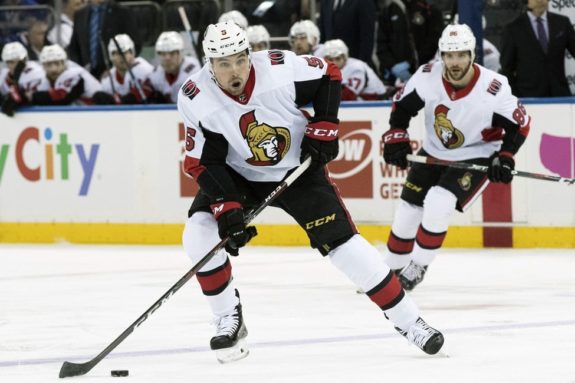
At the heart of the matter, the trade was simply about clearing cap space for the Maple Leafs, especially in the long-term. Offloading Zaitsev and the remaining five years of his costly contract ($4.5 million per season) plus Brown gave Toronto an extra $6.1 million in cap space, while the only notable money coming back was in the form of Ceci, who eventually signed a one-year, $4.5-million extension on July 4. While both Zaitsev and Ceci could be considered overpaid, the Maple Leafs essentially exchanged five years of Zaitsev for just one year of Ceci – a trade they’d take any day.
But aside from purely fiscal matters, there is some intrigue surrounding the players involved – namely Ceci. A former first-round pick, the 25-year-old defenceman never really reached his potential in the NHL after putting up gaudy numbers in the Ontario Hockey League. He wasn’t helped, of course, by playing on a generally poor Senators team. Since his debut in 2013-14, the Senators have made the playoffs just twice, and the last two seasons have been particularly dreadful with a last-place finish in 2018-19 and a second-to-last place finish the year prior.
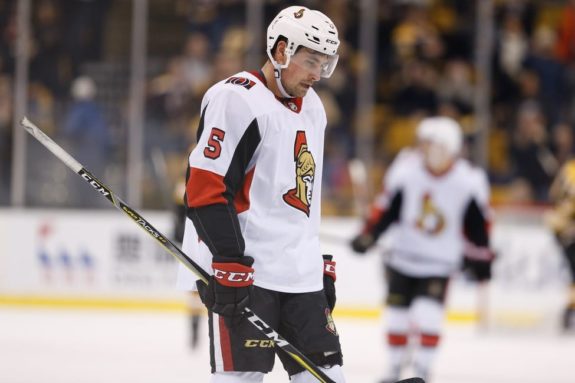
The hope for the Maple Leafs is that it was the Senators dragging down the player, and not the other way around. Perhaps there is some undiscovered value in Ceci. Can he find his game and turn over a new leaf in Toronto?
Ceci’s Results in Ottawa
Over the last two seasons, Ceci was Ottawa’s most deployed player, and it wasn’t particularly close. In 156 games, he played over 3500 minutes – 700 minutes more than the second-most deployed Senator, Thomas Chabot. Adjusting for ice time per game, Ceci played more than everyone not named Erik Karlsson. The former Norris Trophy winner played an eye-popping 26:44 per game in 2017-18 with the Senators, with Ceci clocking in at 22:58 over the last two seasons. For reference, that’s more than every defenceman on the Maple Leafs. Morgan Rielly has led the charge for Toronto with 22:23 per game over that same span, but he’s a proven top-pairing defenceman; Ceci is not.
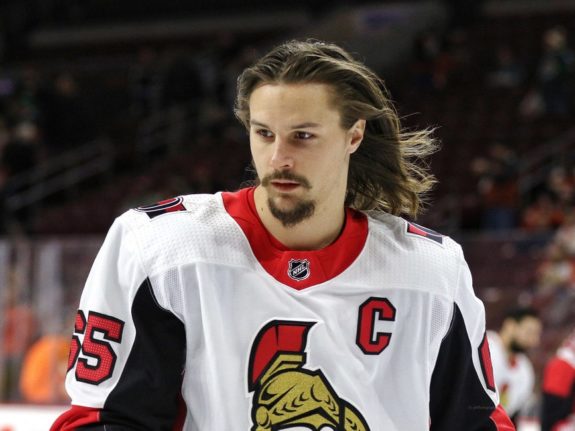
That leads us to our first point: Ceci was clearly overused and out of his depth in Ottawa – and that’s not his fault. As mentioned, the Senators have been a disaster for the past two seasons. He was genuinely one of their best options on defence, which is why he’s played nearly 23 minutes per night against top competition.
Let’s compare his results during his first three seasons in Ottawa, where he averaged just 18:47 of ice time per game, to the last three seasons, where he played 23:02. Note that all stats used are per 60 rates and relative to teammates (to adjust for team performance and context).
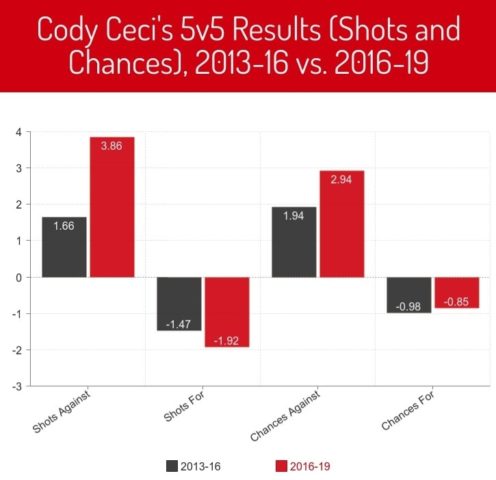
This chart illustrates Ceci’s results pertaining to shots and scoring chances. If you look closely, you’ll notice a pattern (and no, I’m not referring to the pattern of him being consistently worse than his teammates in every category, although that is true). What you should notice is that his offensive results have been consistent throughout his career: he’s always been just below average at generating shots and chances. The real difference is found in his defensive metrics, as he’s allowed far more shots and chances against per hour over the last three seasons.
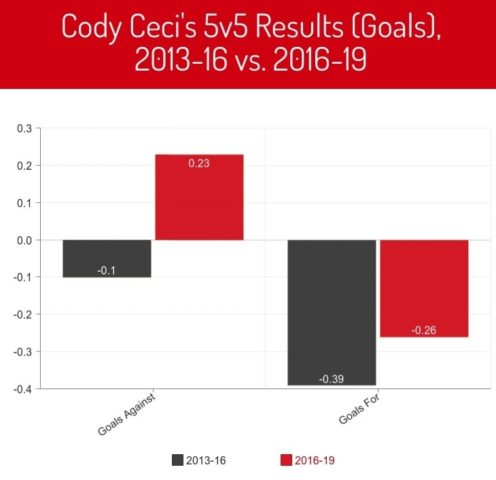
Ceci’s on-ice goal metrics follow a similar pattern. He actually improved slightly over the past three seasons when it comes to on-ice goal production (the Senators started scoring more when he was on the ice). However, he went from a slightly above average defensive player – at least in terms of goals against – to below average (the red goals-against bar indicates that he allowed more goals relative to his teammates from 2016 onwards).
Can we conclude that Ceci’s declining defensive metrics are a result of playing too many minutes against tough competition? It’s hard to say definitively, but it’s almost certainly a major contributing factor.
If that is the case, perhaps the Maple Leafs can use this knowledge to set Ceci up for success this season.
How Should Ceci Be Used in Toronto?
It’s clear that Ceci was misused in Ottawa, but given all the information at hand, the Maple Leafs can create a plan to hopefully increase his efficiency. That plan starts with more appropriate ice time allotment.
Looking at the Maple Leafs’ lineup last season, here’s how ice time was spread across their defensive personnel.
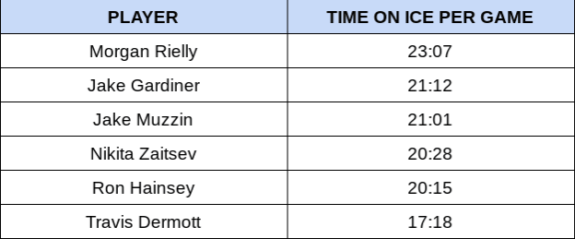
In traditional Mike Babcock fashion, the Maple Leafs bench boss preferred to spread responsibility across all of his lines. Four of the six Maple Leafs defenders played 20 to 21 minutes per night, while No. 1 Rielly played a bit more and young Travis Dermott played a bit less.
Ceci likely doesn’t fit into Toronto’s plans on either special teams unit, which means he’ll lose a chunk of ice time there. If he figures to be the No. 4 or 5 defenceman on the Maple Leafs, he’ll likely see around 18-20 minutes of ice time per game. We know that Cheeci had his best results in Ottawa when playing right around 19 minutes per game, and that’s exactly where he should fit in Toronto if they want to get the most out of him.
We also know that he struggles mightily on the defensive side of the puck. Last season, he was the second-worst defenceman in the league in terms of shots against per hour (38.16 SA/60), and sixth-worst in terms of goals against per hour (3.32 GA/60). As alluded to earlier, some of that can be attributed to being on a terrible Senators team, but a lot of that can be attributed to his poor defensive acumen.
That said, it’s clear that Ceci needs a defensive stalwart beside him in order to be successful: someone that can cover up his mistakes and bail him out. According to him, Maple Leafs management said that they envision him playing beside either Rielly or Jake Muzzin. And during an informal team skate on Sept. 3 that seemed to be proven true as Ceci skated alongside Rielly, while Tyson Barrie lined up with Muzzin.
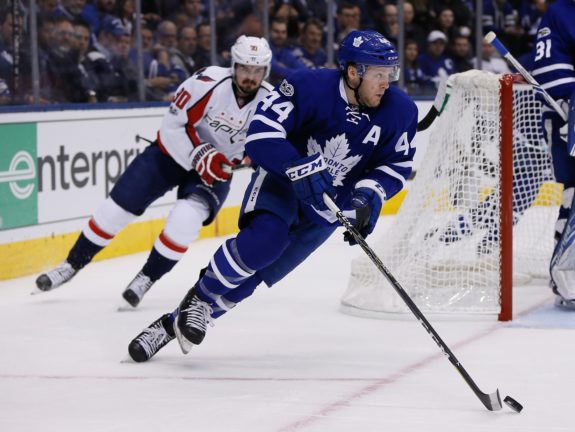
But given that Rielly was just as bad at defence as Ceci last season (ranking fourth-last in SA/60 and sixth-last in expected GA/60), that pairing doesn’t make a ton of sense, and likely isn’t sustainable if the Maple Leafs want to contend. However, the logical pairing of Ceci and Muzzin leaves Rielly with Barrie, a potential defensive disaster of its own. These issues will all be solved when Dermott returns from injury, as he should be able to slot into the team’s top-four. But until then, the Maple Leafs will likely have to make do with Ceci playing significant minutes, which could really handcuff their defensive pairings.
Ceci’s Upside
We’ve talked a lot about Ceci’s shortcomings, but there is some potential upside here for the Maple Leafs. What he lacks in defending, he makes up for in puck-moving ability. And when comparing him to Zaitsev, we can see a stark contrast.
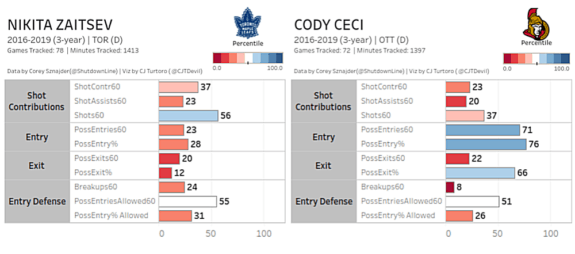
Note the entry and exit stats. Entry refers to how often the player enters the offensive zone with possession of the puck by either skating it in or passing to a teammate. Exit refers to how often the player leaves his defensive zone with possession. We know that controlled zone entries lead to more shots, chances, and goals than uncontrolled entries (ie. dump ins), which is why these metrics are so important.
In the case of Ceci, it’s clear that he’s a huge upgrade over Zaitsev when it comes to both zone exits and entries. What this means in practicality for the Maple Leafs is that they’ll see an immediate improvement in how their defence transitions the puck up to the forwards. Ceci isn’t elite by any means, but you can expect to see more accurate passes and fewer of the aimless dump outs that were so common for the Maple Leafs last season.
One of the ways that the Maple Leafs love to transition the puck from defence to offence is with the stretch pass which, when executed properly, is a two-in-one zone exit and entry. According to The Point, Toronto attempted the stretch pass more than any other team over the past two seasons.
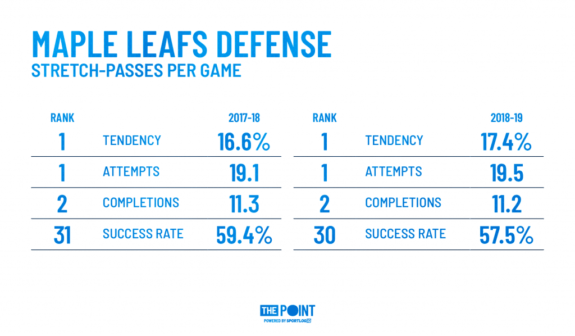
And as I’ve discussed in a previous article, Ceci’s ability to stretch the ice is likely one of the key attributes that made him attractive to the Maple Leafs.
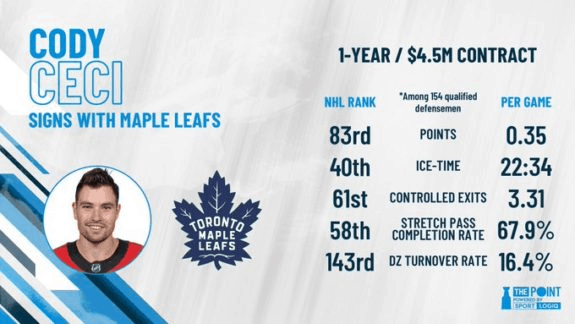
Ranking 61st in controlled exits and 58th in stretch passes last season, Ceci could be considered a top-pairing defenceman in terms of his transitional ability. For a team that had Zaitsev and Ron Hainsey in their top-four or five last season, the addition of a player like Ceci will help tremendously when it comes to moving the puck up to the forwards. If he can get the puck out of his zone quickly (and overcome his terrible habit of turning it over), that’s less time the Maple Leafs will have to spend defending.
Ultimately the challenge for him will be in how he adjusts to a new role on a new team, and whether he can improve at all on the defensive side of things. Will he finally realize the potential that made him a first-round draft pick in 2012, or has the 25-year-old reached the point where he is what he is?